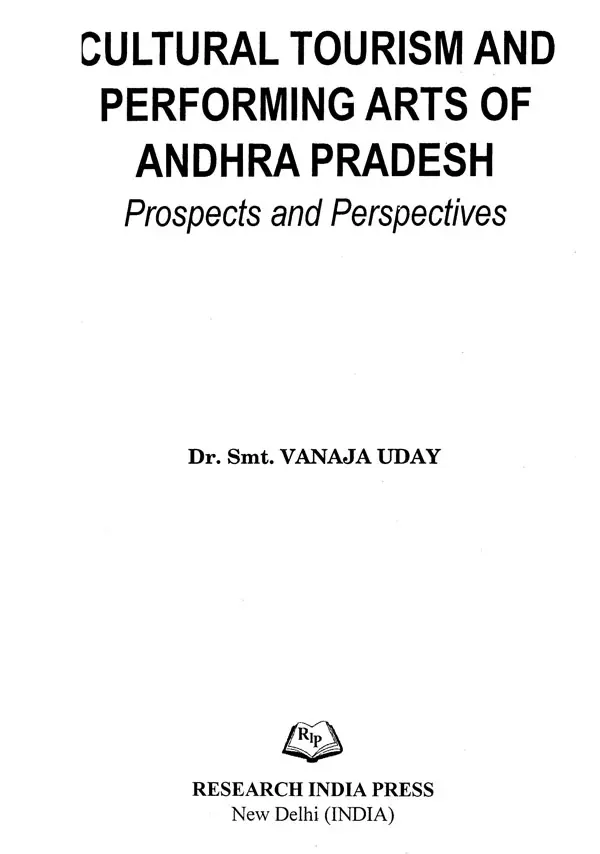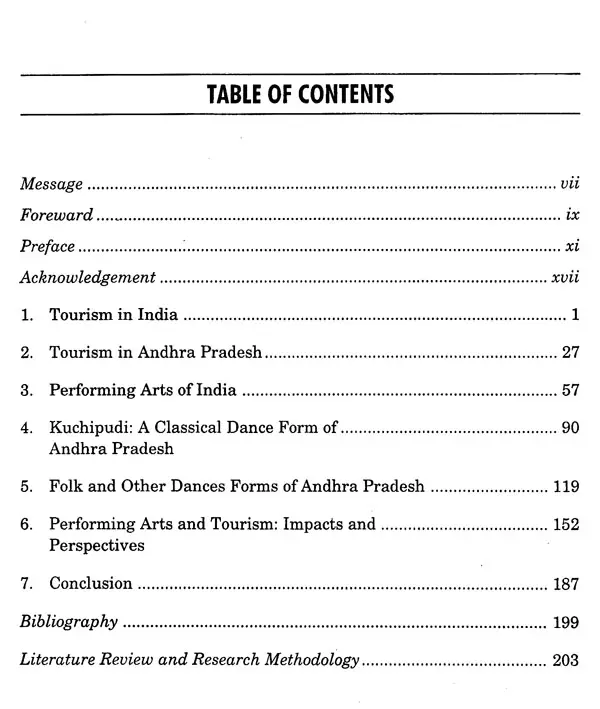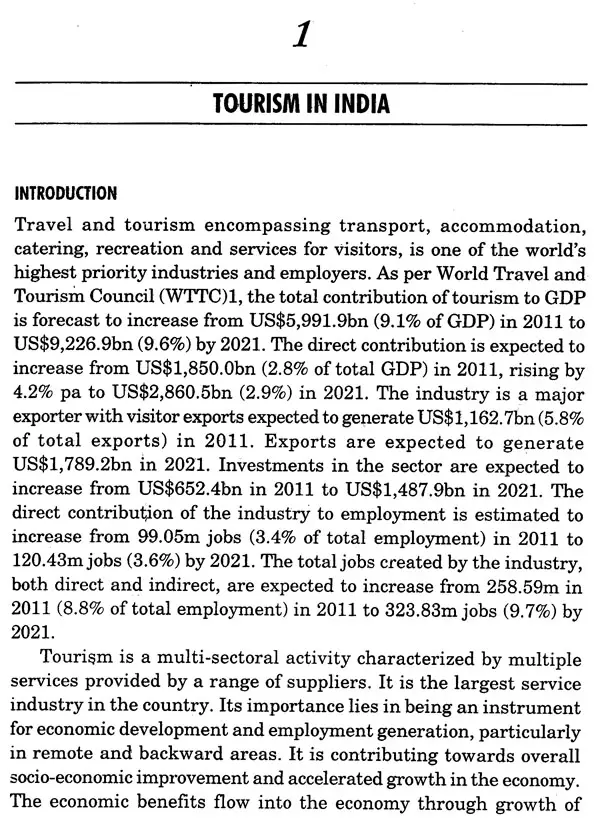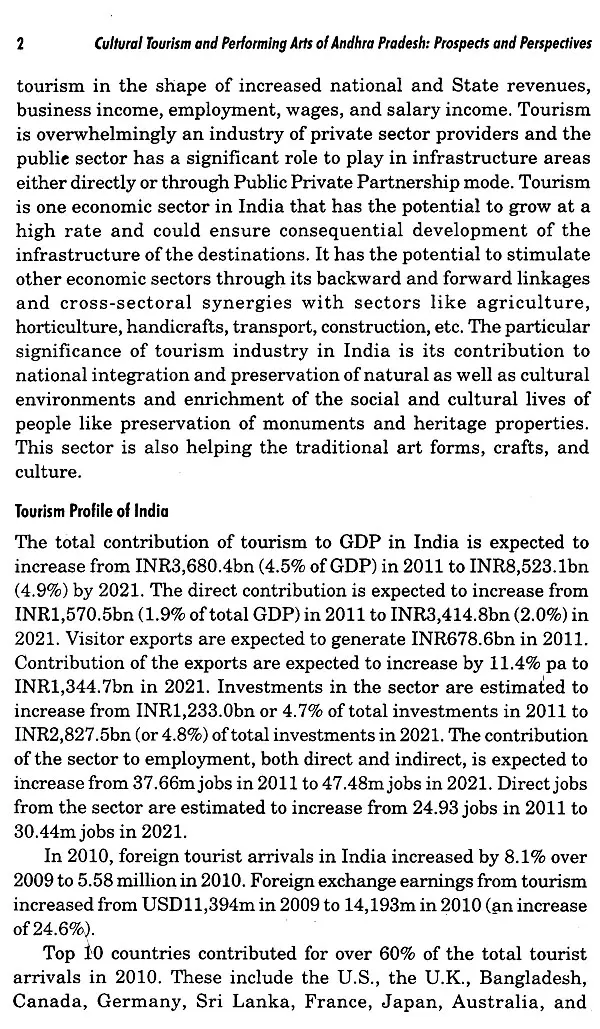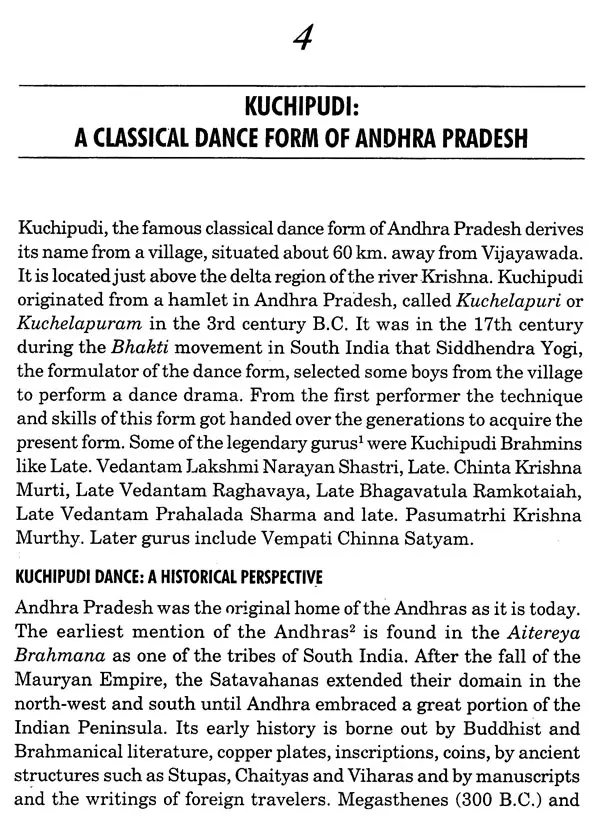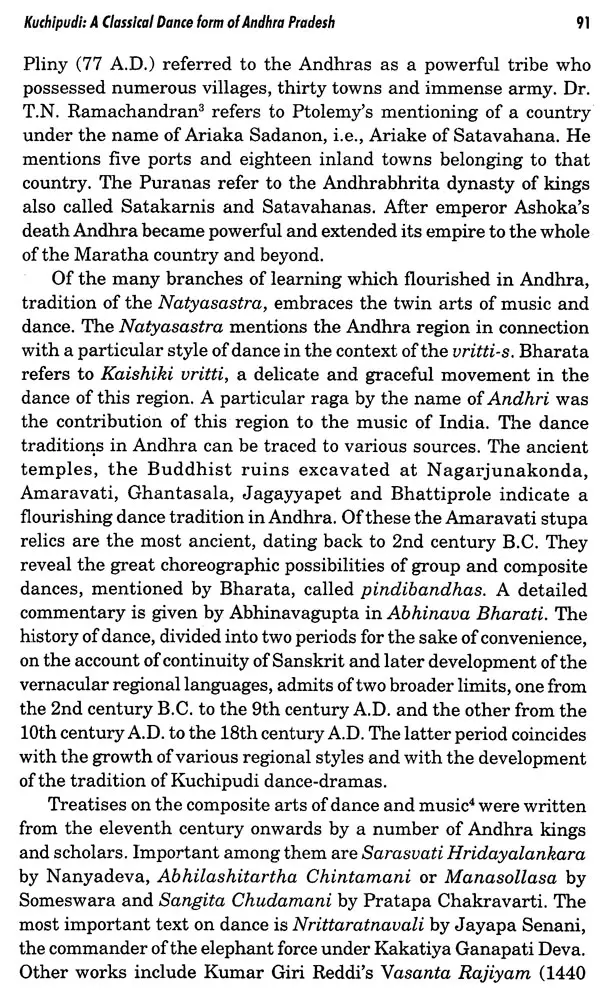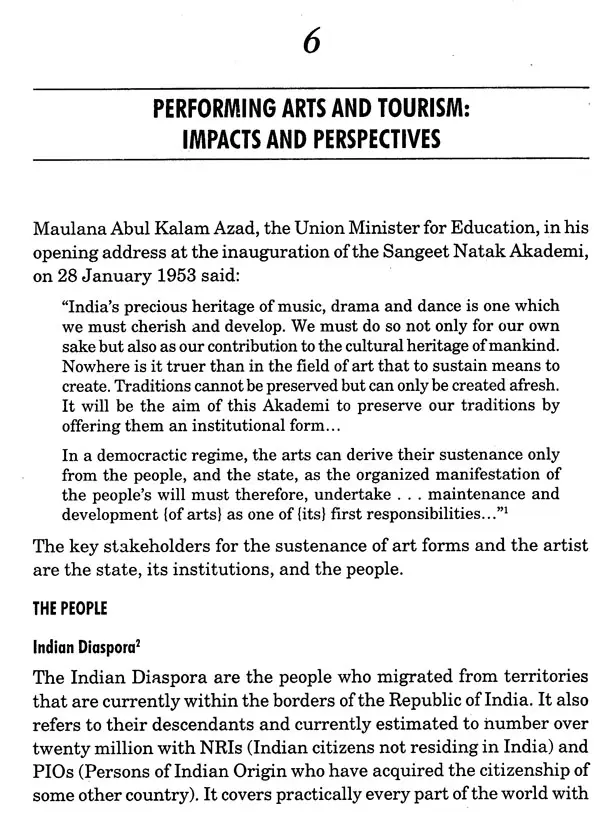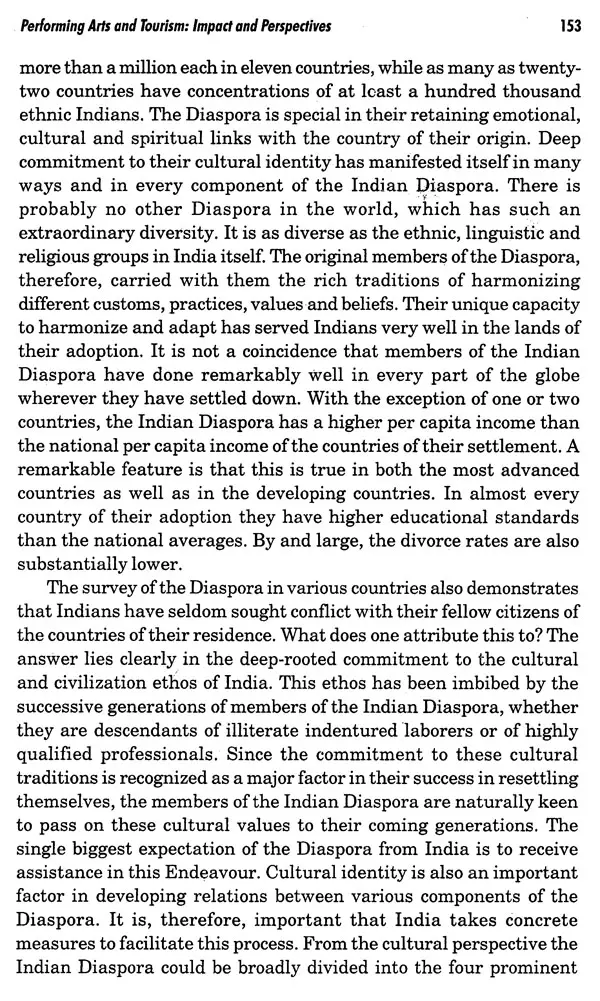
Cultural Tourism and Performing Arts of Andhra Pradesh- Prospects and Perspectives
Book Specification
| Item Code: | UAK194 |
| Author: | Vanaja Uday |
| Publisher: | Research India Press |
| Language: | English |
| Edition: | 2012 |
| ISBN: | 9788189131586 |
| Pages: | 205 |
| Cover: | HARDCOVER |
| Other Details | 9.50 X 6.50 inch |
| Weight | 520 gm |
Book Description
The book in its seven chapters encapsules various facets of Cultural Tourism and Performing Arts of Andhra Pradesh (Prospects and Perspectives). Chapter one while introducing the subject furnishes information on the current trends of Tourism in India, emphasis on Tourism in 10 and 11 -five year plans and Tourism strategies adopted for its promotion . Chapter-2 discussion on A.P Tourism Policy-2010 with key focus Areas, incentives and concessions offered to the stakeholders, strategic planning for promotion of Cultural and Heritage Tourism in A.P., Tourism products, Cultural Tourism Market, (CTM) promotion of Cultural Tourism in the Public Sector, Government initiatives, effectiveness of current Cultural Tourism Marketing, Image improvement and Target Marketing, Strategic action plan and promotion of festivals in Culture Tourism. Chapter-3 highlights various performing arts of India. evolution of dance and classical dance form in India and linkage between dance and tourism. Chapter-4 elucidates exclusively on Kuchipudi, a Classical Dance form of Andhra Pradesh in its historical perspective, distinctive features, Siddhendra Yogi's contribution for Kuchipudi dance and its systematisation and Kuchipudi as a destination and dance form. Chapter-5 embodies folk and other dance forms of Andhra Pradesh against the background of Indian Folk traditions as medium of communication and folk and other dance forms in modem context.
Chapter-6 dwelves on performing arts and Tourism which also examines impacts and perspectives, Indian Diaspora, expectations from India, existing arrangements for cultural promotion, Telugu Associations and other organisations, Artists and Art forms, and Artists perspectives on promotion of Dance forms. The last chapter recapitulates the entire study and looks at the dance forms and their promotion from the perspectives of sustaining cultural indentity and suggests that disjointed marketing and lack of innovative programming in event management which is limiting the number of programmes available to the artists and the promotion of art from with special reference to Kuchipudi Dance.
Kalaratna Dr. Vanaja Uday got her education at Hyderabad. She did her M.A in Kuchipudi Dance from Sri Potti Sree Ramulu Telugu University Hyderabad in 1991, M.A Sociology from Osmania University, Hyderabad. She also did Post Graduate Diploma in Public Relations from Dr. B.R Ambedkar Open University, Hyderabad Diploma in Bharata Natyam from Sri Tyagaraja Government College of Music and Dance, Hyderabad. Diploma in Spanish from Central Institute of English and Foreign Languages, Hyderabad. Diploma in Tourism Studies from IGNOU, and was awarded the Degree of Doctor of Philosophy from Sri Potti Sree Ramulu Telugu University, Hyderabad. As a National Level and A Grade Artist she visited more than 40 countries and gave several stage performances and conducted workshops on Dance. She received many prestigious awards and honours from National and International Cultural Organizations. To name of few Sringar Mani by Sur Singar Samsad, Mumbai, Gaurav Puraskar by Delhi Telugu Academy, Ugadi Puraskar, Kalaratna Puraskar, Rajeev Pratibha Puraskar byAndhra Pradesh Government.
She has participated in many seminars and presented research articles on classical dance forms of India and dynamics of Kuchipudi Dance besides a good number of lecture demonstrations on the subject. Dr. Vanaja Uday is currently working as Assistant Professor Department of Dance, Sri Potti Sree Ramulu Telugu University, Hyderabad. At present she is working on commodification of Cultural Arts forms and Tourism Promotion in India. She is happily married to Sri Uday, who is a source of inspiration to her and blessed with a son Tanay.
Song, dance, drumming, improvisatory versification, reciting, impersonation, performance on diverse musical instruments, or invocations could be seen as a part of ceremonial observances across the stages of human evolution. These medium led to evolution of art as a tool for expression of human emotions. In South Asia, dance is an integral part of worship, life-cycle rituals, seasonal festivals, regional and national celebrations, and popular culture. Dance as a medium of expression is prominently reflected in Hinduism through dancing images of deities and devotees in both the Vaisnavite and Saivite traditions. In South Asia, dance is an integral part of worship, life-cycle rituals, seasonal festivals, regional and national celebrations, and popular culture. This book describes the performing arts of India particularly Andhra Pradesh with specific reference to cultural tourism.
`Performing Arts of India' details various life cycle occasions as reasons for celebration through dance; the key texts; and the tradition of dance. Occasions for celebration such as religious festivals, marriage ceremonies are described. Reference of dance treatises including Bharata Muni's Natyasastra; Visnudharmottara Purana; Sanitasamyasara, Sangitaratnakara; Nrttaratnavali; Manasollasa; Sangitasamyasara; and Nartananirnaya are drawn for the main categories of Marga and Desi styles further divided into Natyadharmi or the conventional tradition; and Lokadharmi or the realistic tradition. The dances are classified based on cultural systems as Aradhana Nrityalu or spiritual or ritual dances for worship; Sastreeya Nrityalu or classical dances; Prachara Nrityalu or traditional or popular dances; Janapada Nrityalu or folk dances; and Atavika Nrityalu or tribal dances. Based on the audience, dances are classified as ones for Gods such as Ritual dances; ones for kings and intellectuals such as court dance or kelika; and ones for common people such as open air performances e.g., Parijatams.
According to Bharata Muni, Natya is an amalgam of wisdom, knowledge, art, craft, device and action. The most common classical dance forms identifiable are Bharatanatyam, Kathakali, Mohiniyattam, Odissi, Kathak, Kuchipudi, and Manipuri. Apart from the classical dance forms, there are folk idioms. 'Folk' indicates community and expressions that are spontaneous. All dance forms are centered on nine rasas or emotions - hasya (happiness), krodha (anger), bhibatsa (disgust), bhaya (fear), viram (courage), karuna (compassion), adbhuta (wonder) and shanta (serenity). Influenced by the tenets of Natyasastra, the dance forms bring out different kinds of postures, and mudras or hand movements, each depicting particular meaning, and talk about the construction of stage, makeup and the orchestra. All dance forms are structured around nritta or the rhythmic elements, nritya or the combination of rhythm and expression, and natya or the dramatic element.
The quality of performances in Indian dance is governed by the performer-audience relationship. The performance with sattva or the luminous communicative energy resulting from the performer's bodily movements and focus, is flavored with appropriate emotion or bhava. A sa-hridaya or sympathetic yet critically discerning viewer or rasika apprehends bhava as a rasa, a reflective experience of tasting. For a performance to be successful there must be rasa. Rasa may involve pratyaksha, a spontaneous experience of insight with performers attributing creative improvisation to the presence of rasika (s). Historically, audiences have varied with ones supporting secular dancing (Shilappadikaram in second century A.D.), theological dancing (Abhinavagupta), erotic devotional dances (Kshetrayya, Jayadeva), to dances reconstructing identities.
Cultural Tourism is one of the fastest growing global Tourism Markets in which India is not an exception Culture and creative industries are increasingly being used by the policy makers to promote destinations and enhance their competitiveness and attractiveness. Many locations throughout the world are now actively developing their tangible and intangible Cultural assets as a means of developing competitive advantages in an increasingly competitive tourism market place and to create local distinctiveness in the process of globalization.
The book, Cultural Tourism and Performing Arts of Andhra Pradesh, examines the growing relationship between Tourism and Culture the way which they have together become major divers of cultural Tourism products of Andhra Pradesh with special reference to performing Arts. Dr. Vanaja Uday a national level Artist and Teacher of Dance has so successfully attempted to identify various problems that the performing Artists are facing and offered various suggestions to enhance the chances for making Cultural Tourism which results into benefitting them.
The book will be an essential reading for academics, policy makers, other stakeholders and all those in Tourism sector who wish to understand the relationship between Culture, Tourism, performing arts and destinations enriched with various Cultural Tourism Assets for which the state of Andhra Pradesh is replete. I congratulate Dr. Vanaja Uday, for her serious involvement not only in conducting research but also bringing out a book for the benefit of the many. I appreciate her for her excellent skill in putting across various aspects of the topic so far left unresearched.
**Contents and Sample Pages**
